
Sanctuary of Athena Pronaia near Delphi, Greece. (1.6M)
From the Athena entry in Wikipedia:
Athena or Athene, often given the epithet Pallas, is an ancient Greek goddess associated with wisdom, handicraft, and warfare who was later syncretized with the Roman goddess Minerva. Athena was regarded as the patron and protectress of various cities across Greece, particularly the city of Athens, from which she most likely received her name. The Parthenon on the Acropolis of Athens is dedicated to her. Her major symbols include owls, olive trees, snakes, and the Gorgoneion. In art, she is generally depicted wearing a helmet and holding a spear.
From her origin as an Aegean palace goddess, Athena was closely associated with the city. She was known as Polias and Poliouchos (both derived from polis, meaning "city-state"), and her temples were usually located atop the fortified acropolis in the central part of the city. The Parthenon on the Athenian Acropolis is dedicated to her, along with numerous other temples and monuments. As the patron of craft and weaving, Athena was known as Ergane. She was also a warrior goddess, and was believed to lead soldiers into battle as Athena Promachos. Her main festival in Athens was the Panathenaia, which was celebrated during the month of Hekatombaion in midsummer and was the most important festival on the Athenian calendar.
In Greek mythology, Athena was believed to have been born from the forehead of her father Zeus. In some versions of the story, Athena has no mother and is born from Zeus' forehead by parthenogenesis. In others, such as Hesiod's Theogony, Zeus swallows his consort Metis, who was pregnant with Athena; in this version, Athena is first born within Zeus and then escapes from his body through his forehead. In the founding myth of Athens, Athena bested Poseidon in a competition over patronage of the city by creating the first olive tree. She was known as Athena Parthenos "Athena the Virgin," but in one archaic Attic myth, the god Hephaestus tried and failed to rape her, resulting in Gaia giving birth to Erichthonius, an important Athenian founding hero. Athena was the patron goddess of heroic endeavor; she was believed to have aided the heroes Perseus, Heracles, Bellerophon, and Jason. Along with Aphrodite and Hera, Athena was one of the three goddesses whose feud resulted in the beginning of the Trojan War.
She plays an active role in the Iliad, in which she assists the Achaeans and, in the Odyssey, she is the divine counselor to Odysseus. In the later writings of the Roman poet Ovid, Athena was said to have competed against the mortal Arachne in a weaving competition, afterward transforming Arachne into the first spider; Ovid also describes how she transformed Medusa into a Gorgon after witnessing her being raped by Poseidon in her temple. Since the Renaissance, Athena has become an international symbol of wisdom, the arts, and classical learning. Western artists and allegorists have often used Athena as a symbol of freedom and democracy.
All pictures are © Dr. Günther Eichhorn, unless otherwise noted.
Goddess of wisdom, handicraft, heroism, courage, war, strategy, industry, and cities.
She is a member of the Twelve Olympians.
Zeus married the goddess Metis, who is described as the "wisest among gods and mortal men", and engaged in sexual intercourse with her. After learning that Metis was pregnant, however, he became afraid that the unborn offspring would try to overthrow him, because Gaia and Ouranos had prophesied that Metis would bear children wiser than their father. In order to prevent this, Zeus tricked Metis into letting him swallow her, but it was too late because Metis had already conceived.
After swallowing Metis, Zeus took six more wives in succession until he married his seventh and present wife, Hera. Then Zeus experienced an enormous headache. He was in such pain that he ordered someone (either Prometheus, Hephaestus, Hermes, Ares, or Palaemon, depending on the sources examined) to cleave his head open with the labrys, the double-headed Minoan ax. Athena leaped from Zeus's head, fully grown and armed. The "First Homeric Hymn to Athena" states in lines 9–16 that the gods were awestruck by Athena's appearance and even Helios, the god of the sun, stopped his chariot in the sky. Pindar, in his "Seventh Olympian Ode", states that she "cried aloud with a mighty shout" and that "the Sky and mother Earth shuddered before her."
Athena's epithet Pallas is derived either from πάλλω, meaning: "to brandish [as a weapon]", or, more likely, from παλλακίς and related words, meaning "youth, young woman". On this topic, Walter Burkert says "she is the Pallas of Athens, Pallas Athenaie, just as Hera of Argos is Here Argeie." In later times, after the original meaning of the name had been forgotten, the Greeks invented myths to explain its origin, such as those reported by the Epicurean philosopher Philodemus and the Bibliotheca of Pseudo-Apollodorus, which claim that Pallas was originally a separate entity, whom Athena had slain in combat.
In one version of the myth, Pallas was the daughter of the sea-god Triton; she and Athena were childhood friends, but Athena accidentally killed her during a friendly sparring match. Distraught over what she had done, Athena took the name Pallas for herself as a sign of her grief. In another version of the story, Pallas was a Gigante; Athena slew him during the Gigantomachy and flayed off his skin to make her cloak, which she wore as a victory trophy. In an alternative variation of the same myth, Pallas was instead Athena's father, who attempted to assault his own daughter, causing Athena to kill him and take his skin as a trophy.
The palladion was a statue of Athena that was said to have stood in her temple on the Trojan Acropolis. Athena was said to have carved the statue herself in the likeness of her dead friend Pallas. The statue had special talisman-like properties and it was thought that, as long as it was in the city, Troy could never fall. When the Greeks captured Troy, Cassandra, the daughter of Priam, clung to the palladion for protection, but Ajax the Lesser violently tore her away from it and dragged her over to the other captives. Athena was infuriated by this violation of her protection. Although Agamemnon attempted to placate her anger with sacrifices, Athena sent a storm at Cape Kaphereos to destroy almost the entire Greek fleet and scatter all of the surviving ships across the Aegean.
In Homer's Iliad, Athena, as a war goddess, inspired and fought alongside the Greek heroes; her aid was synonymous with military prowess. Also in the Iliad, Zeus, the chief god, specifically assigned the sphere of war to Ares, the god of war, and Athena. Athena's moral and military superiority to Ares derived in part from the fact that she represented the intellectual and civilized side of war and the virtues of justice and skill, whereas Ares represented mere blood lust. Her superiority also derived in part from the vastly greater variety and importance of her functions and from the patriotism of Homer's predecessors, Ares being of foreign origin. In the Iliad, Athena was the divine form of the heroic, martial ideal: she personified excellence in close combat, victory, and glory. The qualities that led to victory were found on the aegis, or breastplate, that Athena wore when she went to war: fear, strife, defense, and assault. Athena appears in Homer's Odyssey as the tutelary deity of Odysseus, and myths from later sources portray her similarly as helper of Perseus and Heracles (Hercules). As the guardian of the welfare of kings, Athena became the goddess of good counsel, of prudent restraint and practical insight, as well as of war. In a founding myth reported by Pseudo-Apollodorus, Athena competed with Poseidon for the patronage of Athens. They agreed that each would give the Athenians one gift and that Cecrops, the king of Athens, would determine which gift was better. Poseidon struck the ground with his trident and a salt water spring sprang up; this gave the Athenians access to trade and water. Athens at its height was a significant sea power, defeating the Persian fleet at the Battle of Salamis-but the water was salty and undrinkable. In an alternative version of the myth from Vergil's Georgics, Poseidon instead gave the Athenians the first horse. Athena offered the first domesticated olive tree. Cecrops accepted this gift and declared Athena the patron goddess of Athens. The olive tree brought wood, oil, and food, and became a symbol of Athenian economic prosperity.
Pseudo-Apollodorus records an archaic legend, which claims that Hephaestus once attempted to rape Athena, but she pushed him away, causing him to ejaculate on her thigh. Athena wiped the semen off using a tuft of wool, which she tossed into the dust, impregnating Gaia and causing her to give birth to Erichthonius. Athena adopted Erichthonius as her son and raised him.
The geographer Pausanias records that Athena placed the infant Erichthonius into a small chest (cista), which she entrusted to the care of the three daughters of Cecrops: Herse, Pandrosos, and Aglauros of Athens. She warned the three sisters not to open the chest, but did not explain to them why or what was in it. Aglauros, and possibly one of the other sisters, opened the chest. Differing reports say that they either found that the child itself was a serpent, that it was guarded by a serpent, that it was guarded by two serpents, or that it had the legs of a serpent. In Pausanias's story, the two sisters were driven mad by the sight of the chest's contents and hurled themselves off the Acropolis, dying instantly, but an Attic vase painting shows them being chased by the serpent off the edge of the cliff instead.
Erichthonius was one of the most important founding heroes of Athens and the legend of the daughters of Cecrops was a cult myth linked to the rituals of the Arrhephoria festival. Pausanias records that, during the Arrhephoria, two young girls known as the Arrhephoroi, who lived near the temple of Athena Polias, would be given hidden objects by the priestess of Athena, which they would carry on their heads down a natural underground passage. They would leave the objects they had been given at the bottom of the passage and take another set of hidden objects, which they would carry on their heads back up to the temple. The ritual was performed in the dead of night and no one, not even the priestess, knew what the objects were. The serpent in the story may be the same one depicted coiled at Athena's feet in Pheidias's famous statue of the Athena Parthenos in the Parthenon. Many of the surviving sculptures of Athena show this serpent.
Herodotus records that a serpent lived in a crevice on the north side of the summit of the Athenian Acropolis and that the Athenians left a honey cake for it each month as an offering. On the eve of the Second Persian invasion of Greece in 480 BCE, the serpent did not eat the honey cake and the Athenians interpreted it as a sign that Athena herself had abandoned them. Another version of the myth of the Athenian maidens is told in Metamorphoses by the Roman poet Ovid (43 BCE – 17 CE); in this late variant Hermes falls in love with Herse. Herse, Aglaulus, and Pandrosus go to the temple to offer sacrifices to Athena. Hermes demands help from Aglaulus to seduce Herse. Aglaulus demands money in exchange. Hermes gives her the money the sisters have already offered to Athena. As punishment for Aglaulus's greed, Athena asks the goddess Envy to make Aglaulus jealous of Herse. When Hermes arrives to seduce Herse, Aglaulus stands in his way instead of helping him as she had agreed. He turns her to stone.
According to Pseudo-Apollodorus's Bibliotheca, Athena advised Argos, the builder of the Argo, the ship on which the hero Jason and his band of Argonauts sailed, and aided in the ship's construction. Pseudo-Apollodorus also records that Athena guided the hero Perseus in his quest to behead Medusa. She and Hermes, the god of travelers, appeared to Perseus after he set off on his quest and gifted him with tools he would need to kill the Gorgon. Athena gave Perseus a polished bronze shield to view Medusa's reflection rather than looking at her directly and thereby avoid being turned to stone. Hermes gave him an adamantine scythe to cut off Medusa's head. When Perseus swung his blade to behead Medusa, Athena guided it, allowing his scythe to cut it clean off. According to Pindar's Thirteenth Olympian Ode, Athena helped the hero Bellerophon tame the winged horse Pegasus by giving him a bit.
In ancient Greek art, Athena is frequently shown aiding the hero Heracles. She appears in four of the twelve metopes on the Temple of Zeus at Olympia depicting Heracles's Twelve Labors, including the first, in which she passively watches him slay the Nemean lion, and the tenth, in which she is shown actively helping him hold up the sky. She is presented as his "stern ally", but also the "gentle... acknowledger of his achievements." Artistic depictions of Heracles's apotheosis show Athena driving him to Mount Olympus in her chariot and presenting him to Zeus for his deification. In Aeschylus's tragedy Orestes, Athena intervenes to save Orestes from the wrath of the Erinyes and presides over his trial for the murder of his mother Clytemnestra. When half the jury votes to acquit and the other half votes to convict, Athena casts the deciding vote to acquit Orestes and declares that, from then on, whenever a jury is tied, the defendant shall always be acquitted.
In The Odyssey, Odysseus' cunning and shrewd nature quickly wins Athena's favor. For the first part of the poem, however, she largely is confined to aiding him only from afar, mainly by implanting thoughts in his head during his journey home from Troy. Her guiding actions reinforce her role as the "protectress of heroes," or, as mythologian Walter Friedrich Otto dubbed her, the "goddess of nearness," due to her mentoring and motherly probing. It is not until he washes up on the shore of the island of the Phaeacians, where Nausicaa is washing her clothes that Athena arrives personally to provide more tangible assistance. She appears in Nausicaa's dreams to ensure that the princess rescues Odysseus and plays a role in his eventual escort to Ithaca. Athena appears to Odysseus upon his arrival, disguised as a herdsman; she initially lies and tells him that Penelope, his wife, has remarried and that he is believed to be dead, but Odysseus lies back to her, employing skillful prevarications to protect himself. Impressed by his resolve and shrewdness, she reveals herself and tells him what he needs to know in order to win back his kingdom. She disguises him as an elderly beggar so that he will not be recognized by the suitors or Penelope, and helps him to defeat the suitors. Athena also appears to Odysseus's son Telemachus. Her actions lead him to travel around to Odysseus's comrades and ask about his father. He hears stories about some of Odysseus's journey. Athena's push for Telemachos's journey helps him grow into the man role, that his father once held. She also plays a role in ending the resultant feud against the suitors' relatives. She instructs Laertes to throw his spear and to kill Eupeithes, the father of Antinous.

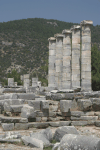


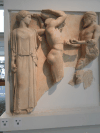
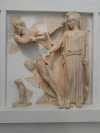
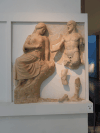
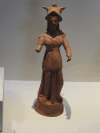
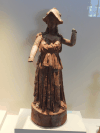

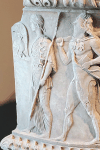
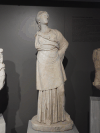
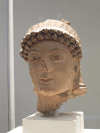
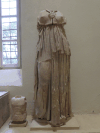
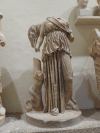
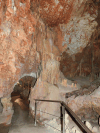
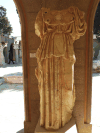
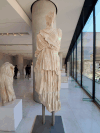
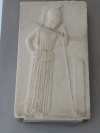
This page contains 19 pictures
Here are the links to the other main pages on Greece:
Page last updated on Fri Dec 2 11:35:52 2022 (Mountain Standard Time)
Athena on soaring.guenther-eichhorn.com